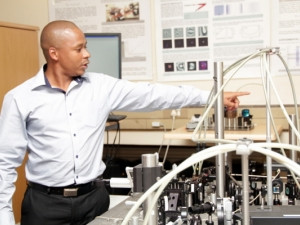
The Council for Scientific and Industrial Research (CSIR) this morning claimed a scientific breakthrough as it officially relayed research that has led to the world's first digital laser.
The technology, developed by Sandile Ngcobo as part of his PHD thesis, is expected to have applications in medicine, communications and manufacturing.
The experiment Ngcobo conducted shows that a mirror in a laser box can be replaced with a digitally-rendered image, which is then used as a map by an LCD display to change the structure of the laser's light.
Professor Andrew Forbes, who heads up the CSIR's mathematical optics research group, says "our digital laser uses the LCD as one of its mirrors that is fitted at one end of the laser cavity. Just as with LCD televisions, the LCD inside the laser can be sent pictures to display.
"When the pictures change on the LCD inside, the properties of the laser beams that exit the device change accordingly."
The patented breakthrough means the laser's beam can be digitally manipulated and allows for cheaper, and quicker customisation of lasers. In conventional optics, the shape of the light is either not controlled at all, or a single shape is selected by expensive optics.
Science and technology minister Derek Hanekom says: "This groundbreaking development is further evidence of the great potential we have in scientific innovation."
Ngcobo says the technology is expected to be disruptive, although exact applications have yet to be worked out.
"The dynamic control of laser modes could open up many future applications, from communications to medicine. Our device represents a new way of thinking about laser technology and we see it as a new platform on which future technologies may be built," says Forbes.
The use of lasers is widespread and they are found in several items, including DVD players and printers. They are also used in manufacturing and for medicinal purposes, such as in surgeries.
[VIDEO=http://www.youtube.com/watch?v=vMRQvWQkIO0]
Share